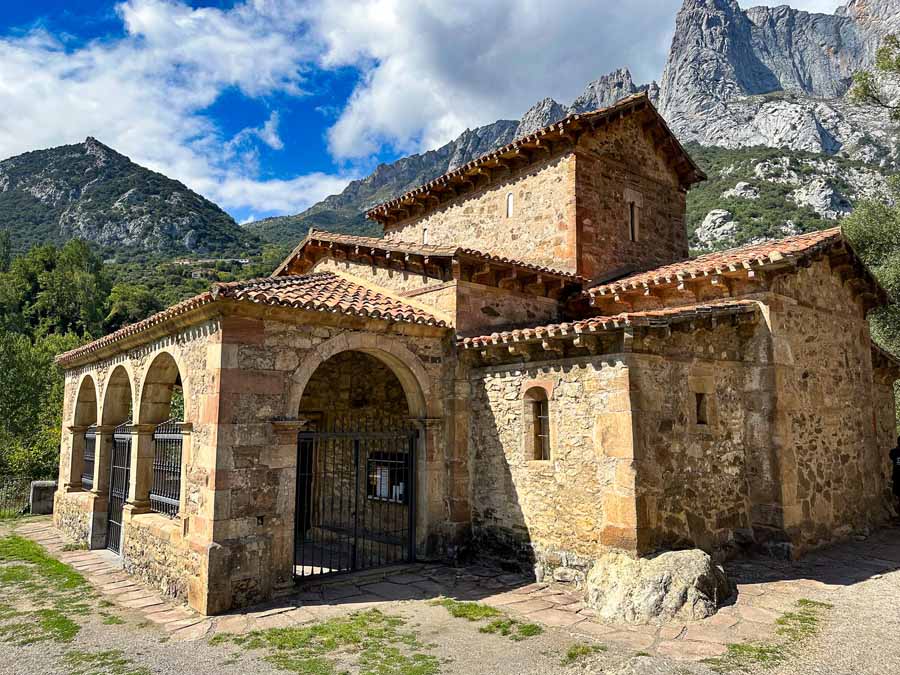Some of the most impressive churches and historical sites are found along the Camino de Santiago routes that twist through the length of Europe. While tourists and pilgrims alike will be drawn to the grand cathedrals on the Camino de Santiago, I find the most special places are the tiny chapels, churches, and unplanned hidden gems
Oftentimes, these small temples allow us a reflective place to contemplate our journey. The quiet can also offer a sanctuary to write, light a candle, or simply feel the sacredness and the “thinness of the veil.”
Each church offers its own treasures and energy.
All of these Camino de Santiago churches and chapels are found along many different Camino de Santiago routes. A handful of these chapels are “off the main path,” which makes them less frequented by visitors.
With each church, I’ve included why each one is so special, which Camino route it’s on, tips for visiting, and if there is an entrance fee.
The following are beautiful Camino de Santiago churches, chapels, tiny monasteries, and hidden gems that are worth a stop or a short detour.
Table of Contents
1 | Church of Saint Mary of Eunate

- Location: near Muruzábal Spain
- Camino de Santiago Route: Camino Frances
- Why it’s so Special: Old energy
- Entrance Fee: €1.50
The 12th-century Romanesque church of Eunate is an easy and short detour on the Camino Frances. The unique church is beautiful on the exterior and is an octagon shape. The origins of this sacred place remain a mystery. Whispers suggest the church was linked to the Knights Templar.
From the Plaza Mayor of Muruzabal village, follow the sign boards to the church. The road follows along a gravel path past endless fields to the Church of Saint Mary of Eunate.
The Eunate Church is small and lovely. The interior is simple, but there is a special energy here.
Maybe that has to do with the original church’s name, “Ehun ate.” In the Basque language, this translates to “one hundred doors.” In the quiet space, it feels as if there is a doorway to another world.
For me, the pure magic of this place is enjoying the solitude of the exterior of the sacred church.
2 | Pre-Romanesque Churches of the Kingdom of Asturias
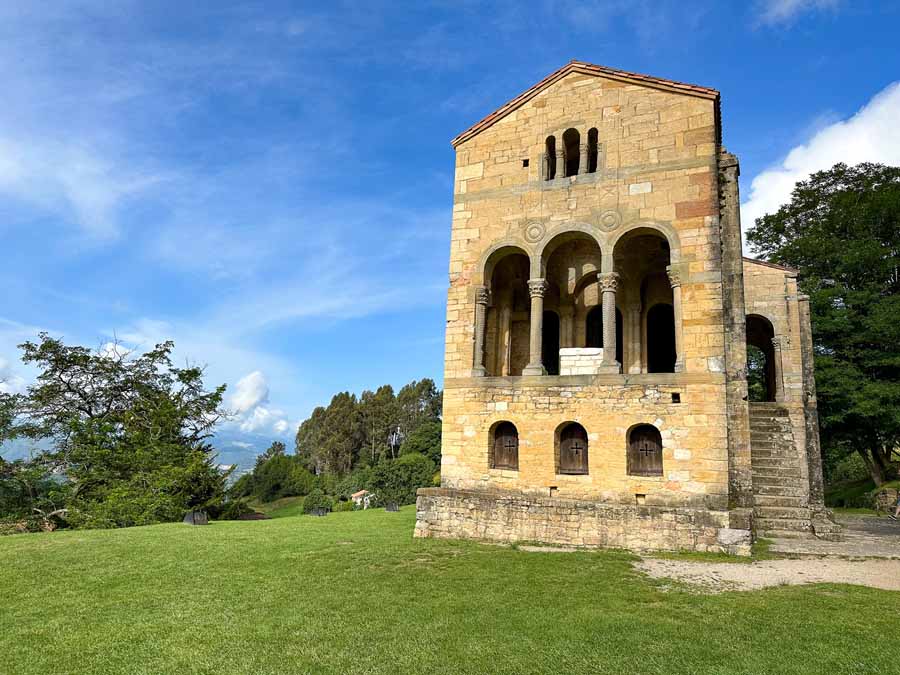

- Location: Monte Naranco Oviedo
- Camino de Santiago Route: Camino de San Salvador or a detour on the Camino Primitivo
- Why it’s so Special: Significant Pre-Romanesque Art that helped inspire the movement towards Christianity
- Entrance Fee: €4 for Santa María del Naranco & San Miguel de Lillo / €2 for Santa Cristina de Lena
There are fifteen monuments recognized as pre-Romanesque architecture in the Kingdom of Asturias. Monuments include old fountains and ancient churches
The two most popular Pre-Romanesque art monuments to visit in Oviedo are the Church of Santa María del Naranco and the Church of San Miguel de Lillo. Both of these 9th-century chapels are located on the slopes of Monte Naranco in Oviedo. There are also additional churches and monuments to see in Oviedo.
The Church of Santa María del Naranco and the Church of San Miguel de Lillo are both recognized as official UNESCO World Heritage Sites of the Monuments of Oviedo and the Kingdom of the Asturias.
Monte Naranco is a short distance from Oviedo and can be reached on foot or via public transportation.
The two Pre-Romanesque chapels of Santa María del Naranco and San Miguel de Lillo can only be visited as part of a guided tour. Santa María del Naranco was once a royal palace and San Miguel de Lilo still has frescos on the ceiling and a unique sculpted panel near the interior door.
If short on time, the exterior views are still worth a visit and there are sweeping views of Oviedo.
On the way of the Camino de San Salvador to Oviedo, you’ll pass by Santa Cristina de Lena tucked up on the hillside with the mountains in the backdrop. This is another fabulous church to visit, but be mindful that this special place has limited hours.
There is something unique and different about these ancient churches designed in the Pre-Romanesque art style. Maybe it’s because they are as old as the Camino de Santiago route itself.
To have enough time to visit the Romanesque architectural churches, it’s better to spend at least one night in Oviedo.
3 | Igrexa da Virxe Peregrina

- Location: Pontevedra Spain
- Camino de Santiago Route: Camino Portugués
- Why it’s so Special: The Chapel floor plan is designed after the Scalloped Shell of the Way
- Donations Encouraged
By far one of the more unique churches on the Camino de Santiago is the Santuario da Virxe Peregrina in Pontevedra. The church is dedicated to the Pilgrim Virgin, the Patron Saint of Pontevedra, and was built during the 18th century and is found on the Camino Portuguese way.
What makes this church special is that the floor plan is actually in the shape of a shell. The church sits in the middle of Praza de Peregrina and is a stopping point for pilgrims on the way to Santiago de Compostela. Shells can be seen inside the church. A water fountain near the front entrance welcomes thirsty pilgrims to rest and appreciate the church.
Pontevedra is a bustling university town and there is plenty of things to see and do here. The city has such great energy that it’s worth sleeping here at least one night to soak in all the ambiance.
4 | Suso Monastery (Part of the Yuso Monastery Complex)


- Location: San Millan de la Cogolla Spain
- Camino de Santiago Route: Detour on the Camino Frances
- Why it’s so Special: This may be the “cradle of the Spanish language”
- Entrance Fee: €4 for Suso Monastery (includes bus ride)
- Pilgrim Discount: €3.25 for Suso Monastery (includes bus ride)
Although not directly on the Camino Frances, the Yuso & Suso Monasteries located in San Millan de la Cogolla are definitely worth a detour. They can be reached as a short detour from Najera of the Camino Frances along the Camino Real.
The Monasteries of Yuso and Suso are listed as a UNESCO World Heritage Site and are found in the tiny hamlet of San Millan de la Cogolla. The only way to visit both sites is as part of a guided tour. Tours are in Spanish, but there are English plaque boards found throughout.
Pilgrims will have to plan accordingly as the hours for each Monastery are different and require two separate entrance tickets. The Suso Monastery must be reached via the bus provided with the ticket purchase. Those walking the Camino can show their credentials to receive a stamp and a pilgrim discount.
The Yuso Monastery is the larger monastery that houses relics, one being a replica of the Glosas Emilianenses. The Gloas Emilianenses are the first-ever known writings in Castilian Spanish.
I especially love the smaller hilltop Monastery of Suso because it was believed that here in the cave system is where the first Spanish writings in Castillian were written. For this reason, it is said that San Millan de la Cogolla is considered to be the “cradle of the Spanish language” as we know it today.
Some say the Monks lived in solitude in the cave systems far before the Suso Monastery was constructed. The Suso Monastery we see today was said to be built during the 6th century.
There is a very special energy at the Suso Monastery. It is something you have to feel to experience. It’s as if you can feel that this site is sacred and “old.” In fact, the Suso Monastery is home to the oldest altar in Spain.
Those looking to experience a different side of the Monastery can sleep at the Yuso Monastery in the Hostería del Monasterio de San Millan.
5 | Church of Santa Maria La Blanca
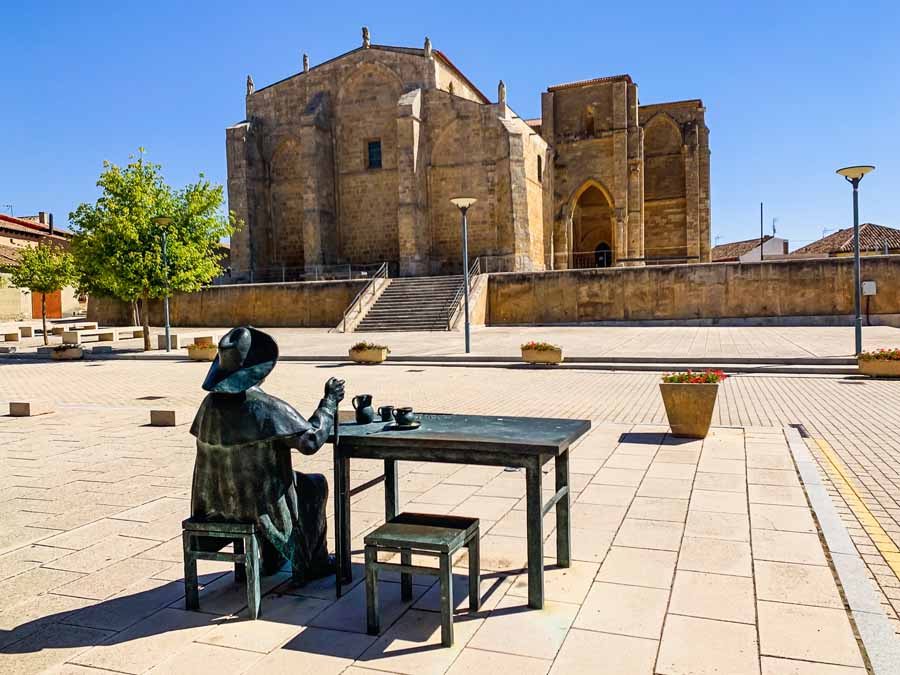
- Location: Villalcazar de Sirga Spain
- Camino de Santiago Route: Camino Frances
- Why it’s so Special: History with the Knights Templar
- Donations Encouraged
There is something really special about the church of Santa Maria la Blanca. It was built at the end of the 12th century and has deep connections to the Knight’s Templar. The Santa Maria la Blanca church beautifully highlights the transition between Romanesque and Gothic architecture.
The Church of Santa Maria la Blanca is found in Villalcazar de Sirga and is extremely welcoming to pilgrims. The plaza is an ideal place to take a rest.
On a hot day, the church provides a nice cool break. However, the church is rich in history and is worth a visit no matter what time of day or year.
The Church of Santa Maria la Blanca boasts a beautiful rose window. It is also home to a statue of Mary who is said to provide healing powers to those who pray to her. Additionally, there are legends that if you walk along the church on the spring equinox the bull’s mouth will point to the Templar’s hidden treasures.
On the way out of town, don’t miss a chance to sit next to the pilgrim statue or sleep in one of the quiet guesthouses.
6 | Igrexa de Santiago Apóstolo de Padrón
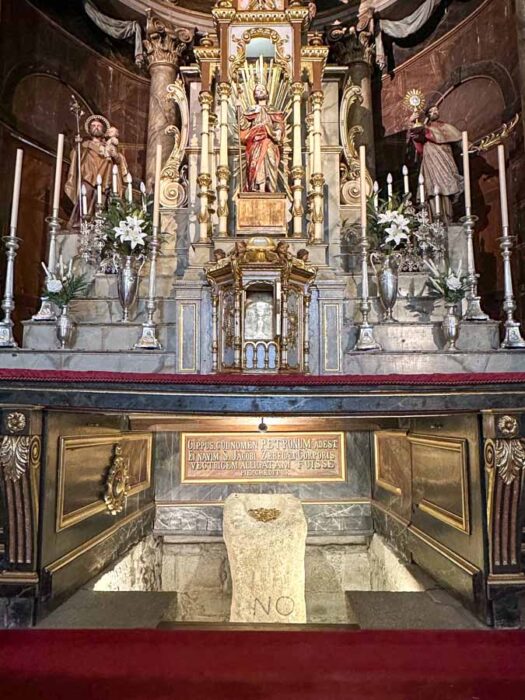
- Location: Padrón Spain
- Camino de Santiago Route: Camino Portugués
- Why it’s so Special: It’s said to hold the mooring post that the stone boat carrying the body of Saint James tied to
- Donations Encouraged
Padrón is it is believed to be where the Apostle of Saint James’ body was returned to Spain after he was beheaded in Jerusalem. The “stone boat” was tied up to a mooring post in Iria Flavia and his devoted disciples Theodore and Athanasius frantically searched for a place for him to be buried.
Of course, the legends continue of how they ran into resistance from the Pagan Queen Lupa, but after miracles and being deceived, his body was buried and Queen Lupa was baptized.
The Church of Santiago in Padrón houses the treasured mooring post that the stone boat was tied up to. The Pedrón, or the stone, sits right below the altar.
Modern pilgrims can follow the Translatio, or the maritime way of the stone boat, by walking the Spiritual Variant (Variante Espiritual). This is an incredible alternative path on the Camino Portuguese that includes a mixture of walking and on the final day taking a boat to Padrón.
For many pilgrims, Padrón is the final sleeping stop before arriving in Santiago de Compostela.
7 | Iglesia de Santiago de Peñalba


- Location: Santiago de Peñalba
- Camino de Santiago Route: A worthwhile detour from the Camino Frances or the Camino de Invierno
- Why it’s so Special: The well-preserved examples of Mozarabic architecture sit in one of the most beautiful pueblos in Spain.
- Entrance Fee: Free but donations are encouraged
The Church of Peñalba de Santiago is said to be one of the most well-preserved examples of Mozarabic architecture. In fact, this tiny chapel is on the tentative UNESCO World Heritage List for Mozarabic Buildings on the Iberian Peninsula. One of the best examples of this architectural style are the two horseshoe arches you pass through to enter the church.
The church was founded by San Genadio and was completed in the year 937 by Abbot Solomon. Inside the no-frills chapel, find remnants of an old mural on the ceiling and the wall.
The true beauty of this chapel is most appreciated on the exterior, where you can walk along the charming streets of Peñalba de Santiago. The village is well connected to many hiking trails through the Valle del Silencio and is encircled by the magnificent Aquilianos Mountains.
As one of Spain’s most beautiful pueblos, it’s worth it to spend the night in Peñalba de Santiago. There is also an albergue in the center of the village, but always make sure and verify it’s open before heading into the mountains.
For me, the journey to Iglesia de Santiago de Peñalba on foot was the most rewarding way to reach the sacred site.
If looking to visit Peñalba de Santiago on foot, start on the Camino de Invierno from Ponferrada.
It’s another detour on a little trekked hiking trail through the Oza Valley. After Peñalba de Santiago, follow the Old Roman Mining Canal trails to Montes de Valdueza, where you can rejoin the Camino de Invierno in the small hamlet of Villavieja.
This is a challenging and isolated route and takes a minimum of two or three days.
8 | Iglesia de Santa Maria (Central Church)

- Location: Rabanal del Camino Spain
- Camino de Santiago Route: Camino Frances
- Why it’s so Special: Tiny Chapel with Big Energy
- Donations Encouraged
Rabanal del Camino is rooted deep in the Camino de Santiago history. The town is found on the slopes of Monte Irago, and often becomes a favorite stopping point for pilgrims to rest and recharge.
Rabanal del Camino was believed to be inhabited by the Knight’s Templar who protected and helped pilgrims pass Monte Irago. It is believed they built the central Santa Maria Church in the town sometime in the 12th century.
The tiny chapel is always quiet and offers a beautiful place to rest and reflect. There is a daily Latin Mass with Gregorian Chants at 19:00 and a pilgrim’s blessing at 21:30. This special chapel is overseen by Bavarian monks. If you miss the service mesmerizing recordings are playing the otherworldly Gregorian chants.
This is one of those very special towns on the Camino de Santiago.
The Bavarian monks also run the Monasterio de San Salvador del Monte Irago across the plaza. This space offers a sacred place for pilgrims to rest and participate in a silent retreat and is donation-based.
Another popular place to stay is The Stone Boat Guesthouse.
9 | Monastery of San Miguel de Escalada

- Location: San Miguel de Escalada (close to León)
- Camino de Santiago Route: Camino Vadiniense
- Why it’s so Special: It is one of the most iconic Mozarabic-style architectural styles found along the route of Monasteries near León
- Entrance Fee: 3€
Since the Middle Ages, León has always had a deep connection with the Camino de Santiago. Beautiful monasteries and chapels can be visited near León on the Route of the Monasteries. Perhaps the most famous is the Monastery of San Miguel de Escalada.
The Monastery of San Miguel de Escalada was said to have been built by Christian monks from Córdoba who were escaping religious intolerance. The first church was built on top of an ancient Visgoth Church that was dedicated to the Archangel Michael.
The church is a prime example of Mozarabic architecture (pre-Romanesque). The current entrance opened its doors in 1050. The porch boasts twelve horseshoe arches which were believed to be designed by the same architect who worked on the church of Peñalba de Santiago.
Inside, there are numerous arches that almost give the feeling of stepping into the Cordoba Cathedral, but on a much smaller scale. Many columns are decorated with motifs and designs. Look up to see the wood panels, which are decorated with paintings from the 15th century.
The church was abandoned around 1836 and went into despair.
Although only a short distance from León, the most adventurous way to access the lonely chapel is on the Camino Vadiniense. This Camino route connects the Camino Lebaniego with the Camino Frances and is named after the tribes who occupied the foothills of the Picos de Europa. These tribes were some of the last to withstand the conquest of the Romans.
While the San Miguel de Escalada Monastery is one of the most famous, the Monasterio de Santa María la Real of Gradefes is also on the Camino Vadiniense and warrants a visit (free for those with a pilgrim credencial).
10 | Iglesia de Santiago


- Location: Villafranca del Bierzo Spain
- Camino de Santiago Route: Camino Frances
- Why it’s so Special: Puerta del Perdón or the “Door of Forgiveness”
- Donations Encouraged
Villafranca del Bierzo is another village on the Camino Frances with a significant history with the Camino de Santiago. The picturesque hilltop village was once called “Little Santiago,” due to its Church of Santiago. The 12th Century Romanesque Church has its very own Door of Forgiveness.
During the Middle Ages, if pilgrims could not continue to Santiago de Compostela due to illness or injury, they could forgiven for their sins by passing through the Puerta del Perdón. The Church of Santiago in Villafranca del Bierzo would issue a Compostela.
Vilafranca del Bierzo is a lovely city nestled in a river valley. Many pilgrims choose to sleep in Vilafranca del Bierzo.
There are three different routes from Vilafranca del Bierzo towards Santiago de Compostela. One of the more challenging routes from Villafrance del Bierzo is the Camino Dragonte. This intrepid trail cuts through the mountains and tiny pueblos surrounded by chestnut forests. It is one of the toughest days on the Camino Frances but one of the most spectacular.
11 | Iglesia de Santa María de Lebeña


- Location: Lebeña
- Camino de Santiago Route: Camino Lebaniego
- Why it’s so Special: Pre-Romanesque Church nestled into the foothills of the Picos de Europa
- Entrance Fee: 2€
The small hamlet of Lebaña is home to the iconic Church of Santa Maria Lebeña. The Iglesia de Santa María de Lebeña is a stunning pre-Romanesque church that was built in 925. It is believed that the church was built on top of a sacred monastery that pre-dated the church.
This Pre-Romanesque church can also be reached on foot via the Camino Lebaniego route. This incredible route takes pilgrims from San Vicente de la Barquera on the Camino del Norte to the Monastery of Santo Toribio Liebana outside of Potes. This sacred site holds the largest piece of Lignum Crucis, the true cross on which Jesus was said to be crucified and also where Saint Turibius is buried.
The Church of Santa Maria Lebeña was originally built with the intent to house the remains of Saint Turibius. There is an interesting legend that claims that the followers who tried to move his remains went blind and did not receive their sight back until they moved his relics back to the Monastery of Saint Toribio.
It is possible to visit the interior of the church, but no photos are allowed. The hours of the church are limited. However, it’s still worth walking around the exterior to marvel at the structure and the incredible nearby mountains of the Picos de Europa National Park.
12 | Ruinas de Santa Mariña

- Location: Cambados
- Camino de Santiago Route: A short detour of the Variante Espiritual Camino Route
- Why it’s so Special: Ruins of an old church surrounded by a cemetery where the “veil seems thin”
- Entrance Fee: Free
A special place to see in Cambados is the Santa Mariña church ruins. Cambados is the capital of the Albariño wine region in Galicia and a short detour off of the Variante Espiritual Route. There is so much to see in Cambados, it’s best to spend the night here.
A small chapel was originally built on this site during the 12th century in Romanesque style, but during the 15th century, the granite church of Santa Mariña was erected. There are still a few archways that remain exposed to the sky.
If you enter the old chapel, it’s possible to see the iconic shells of Saint James that are carved into the walls. Around the ruins of Santa Mariña is a beautiful cemetery still utilized by the local villages. This is one of those special places where the veil seems very “thin.”
On a clear day, head up the hill to Mirador de A Pastora, a viewpoint found on the hillside above the ruins. This is one of the best places to savor a sunset on the Rias Baxias.
13 | Santuario da Virxe da Barca
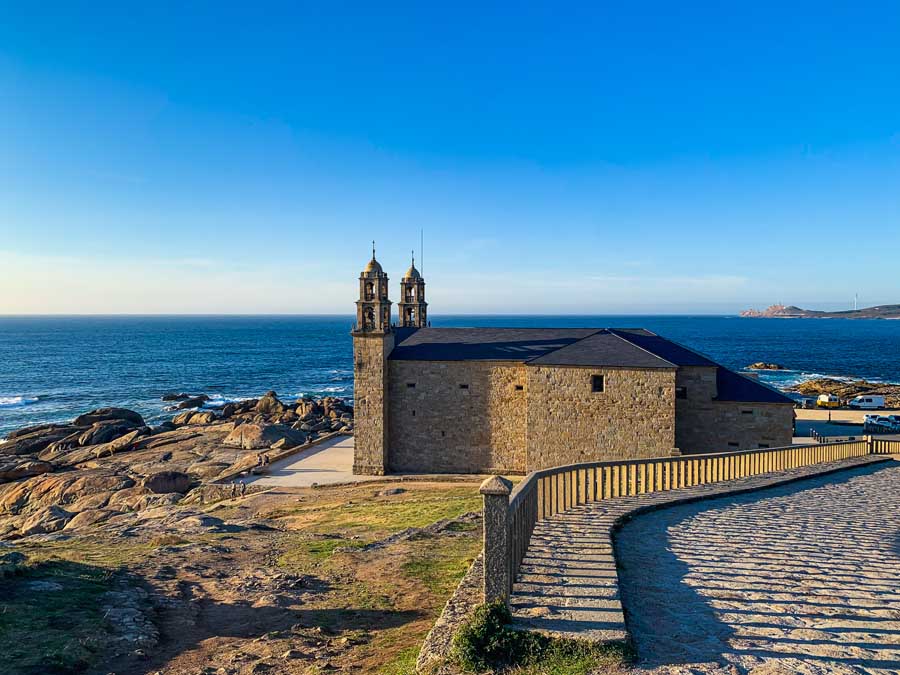
The Camino Finisterre Muxia is the only Camino route that departs the Cathedral de Santiago. This beautiful walk takes pilgrims to the “End of the World” to gaze at the vastness of the Atlantic Ocean.
Pilgrims can choose to walk to Finisterre or Muxia. To me, Muxia is the perfect ending point with its seaside Sanctuary of A Nosa Señora da Barca. This chapel marks the end of a journey for so many pilgrims as they watch the sun dip into the Atlantic Ocean on the shores of the Death Coast.
This church is also marked with legends of where the legends of the Virgin Mary came to comfort the Apostle James. He needed encouragement and the Virgin appeared in a stone boat to tell him he was needed back in Jerusalem. That trip to Jeruselum would lead to his death and martyrdom.
The large stone in front of the chapel is said to be the old rudder of the stone boat that Mary visited James the Apostle. However, many of these stones are ancient and are powerful stones from the Celtic tribes. Some of these stones are said to possess healing powers.
Muxia is an inviting sleepy fishing village with lovely beaches. Don’t miss an epic sunset from the top of Monte Corpiño or simply treat yourself to a good seafood meal.
Many pilgrims stay for a few days in Muxia to reflect on their powerful Camino journey.
Quick Tips on Walking the Camino de Santiago
Feeling inspired to walk the Camino de Santiago? The most important thing to remember is to walk your own path. There are multiple Camino de Santiago routes to choose from, so research which one calls to you. These are the most popular Camino de Santiago starting points.
One of my best tips for first-time walkers is to listen to your body, pack only what you need, and let the magic of the way unfold. Don’t rule out walking in the winter; it’s one of my favorite seasons for the internal journey.
Let go of judgments of yourself and others and be respectful to the locals and the sacristy of the path.
Buen Camino!
More Camino de Santiago Planning Resources
Conclusion | Beautiful Churches & Chapels Found Along the Many Camino de Santiago Routes

These are some of my favorite Camino de Santiago churches, chapels, tiny monasteries, and hidden gems found on all the Camino de Santiago routes I’ve had the pleasure to walk.
For me, some of the tiniest of chapels and churches have left behind some of my most moving experiences along the way
In my experience, the grandest Camino de Santiago churches are actually found in nature from the mountains to the river valleys, and in the depths of the enchanted forests. Some of these grand detours ended up being some of my most memorable days walking the Camino.
The small churches and hidden gems were an inspiration to get off the beaten path and connect deeper with nature.
Did you visit Camino de Santiago churches or chapels you loved and I’m missing? It was so hard to narrow my list down, but these special sites impacted my journey the most. Let me know in the comments below!

